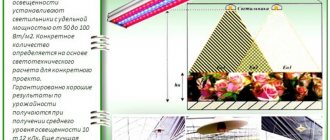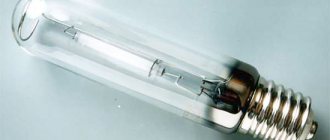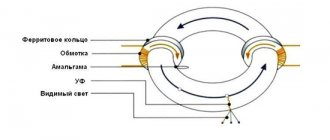Greenhouse lighting lamps are vital for plants. Without enough light, the stems stretch, the fruits do not ripen properly and lose their taste. That's why it's so important to choose the right lamp!
Artificial lighting in a greenhouse allows you to accelerate or slow down the development of plants, as well as the ripening of crops, regardless of the time of year, and reduces the level of nitrates in leaves and fruits. Since green crops require at least 12 hours of light per day, it is worth taking care to install high-quality lamps in the room.
24-hour lighting for plants is contraindicated. They also require at least 6 hours of darkness for normal development.
Regular incandescent bulbs are not suitable for greenhouse lighting because they emit too much heat and do not contain the full spectrum needed. Also, in terms of the emitted spectrum, energy-saving fluorescent lamps are not very suitable, although some use them when growing plants. Therefore, more and more often, summer residents are paying attention to specially designed phytolamps of various types.
Types of lighting for a greenhouse: installation features
When choosing the location of the greenhouse, you should take into account the illumination of the area. It is light that plays an important role in the process of plant development, and its sufficient quantity ensures a good harvest.
Supplemental lighting has a beneficial effect on the vegetative process, which leads to high yields in the greenhouse.
The most light-loving plants include tomatoes, bell peppers, cucumbers and lettuce. These plants urgently need to receive a sufficient amount of light, at least 10 hours a day. However, with the onset of autumn and winter, a lack of light may become a problem. In this regard, it is necessary to install additional lighting, which will ensure the favorable development of the plant crop.
Additional lighting has a good effect on the vegetative system of the plant, thanks to which it produces a larger yield in the greenhouse.
Layout of lamps in a greenhouse.
If you want to equip lighting in a greenhouse, you should remember that the system must be installed above seedlings, young plants or cuttings. The light must be turned on in the morning and evening, but the recommended dose should not exceed the norm. Lighting in the greenhouse should be no more than 16 hours a day. The breed and cultural characteristics should be taken into account. When using artificial lighting in a greenhouse, you get a harvest faster by half a month. Lighting plays a particularly important role in the life of plants in winter.
Plants are able to detect the wavelength of light and its level. Spectral composition plays a key role when choosing greenhouse lighting. For example, you can use lamps of different colors: red (intense) and green (neutral). In order to improve the process of photosynthesis, it is recommended to install red or orange lighting in winter and autumn. Ultraviolet lamps are used to develop frost resistance in the plant and increase the amount of vitamins contained. Less useful rays include green and yellow.
Artificial lighting lamps for greenhouses
It is worth noting that conventional lamps are not suitable for greenhouse conditions, as they contain low efficiency. During the heating process, such lamps do not have a blue color, which is unacceptable for use.
Fluorescent lamps in a greenhouse are the most suitable lighting option. During operation, they practically do not heat up, but provide a very good microclimate for plants. The cost of such lamps is low. You should know that a fluorescent lamp takes up a sufficient amount of space, so sometimes greenhouse owners use alternative light sources, including for lighting in winter.
Greenhouse lighting: mercury and sodium lamps
Diagram of a sodium lamp.
A high pressure mercury vapor lamp is a good choice to place in a greenhouse for efficient lighting during the winter. Some models are specifically designed for artificial lighting in greenhouses. These devices have a beneficial effect on the process of photosynthesis, maintaining optimal air exchange. It is important to emphasize that mercury, which is part of the lamp base, is very dangerous. In this regard, it is imperative to comply with all storage and use rules. It is strictly prohibited to throw a mercury lamp into a container. It requires proper disposal. You should also know that if the lamp breaks, it will be almost impossible to collect the mercury; vegetables and any objects on which the substance has come into contact will have to be thrown away.
Industrial greenhouses often use special sodium lamps. This type is one of the most effective and most suitable for greenhouses. Sodium lamps have a similar spectrum to sunlight. They also have improved performance in the blue and red ranges.
Mirror sodium lamps are designed specifically for use in greenhouse conditions. The mirror surface tends to reflect light, which leads to an increase in efficiency. The base, which rotates, helps to correctly direct the light flux. Sodium lamps can be controlled using a ballast. The lamp is very easy to install. This is done by connecting the ballast. After the lamp is turned on, the luminous flux is directed in the appropriate direction.
In order to independently install lighting in a greenhouse, it is necessary to select the correct ballast and pulse-ignition device.
Diagram of a mercury lamp.
Metal halide lamps are another type that is actively used for lighting greenhouses. These lamps provide good nutrition to plants because they emit light that is close to sunlight. These devices are quite expensive. There are also restrictions on the combustion position.
You can make a lamp for a greenhouse yourself. It is important to take into account that this type of procedure requires good preparation and experience. When choosing lamps, pay attention to the manufacturer and technical specifications. It is recommended to purchase products from well-known brands. A ballast is also needed, which distributes light among the lamps and controls their operation.
If you do not want to deal with the long and painstaking process of equipping lamps, you can use ready-made ones. Lamps can be built into the lamp itself or made into separate units. Thanks to this system, the light flux is distributed evenly. A consultant will help you make an accurate calculation of lamps for a specific greenhouse. It is important to select lamps of appropriate power.
Today, there are new, modern LED lamps on the greenhouse market. They cover the entire visible spectrum. You can make a combination of spectral groups and make a lamp with a suitable light composition. This way you can easily adjust parts of the spectrum. In order to get enough light, you need to have a sufficient number of LEDs.
LED lamps are economical and resistant to mechanical stress, they help make lighting more uniform. Such lamps are very rarely damaged and are ideal for greenhouse conditions. LEDs do not require any special, special disposal. The main feature of this type of lamps is that they are environmentally friendly.
Greenhouse lighting: cable placement, electrification, light equipment
Diagram of the electrical supplementary lighting system.
It is important to know how to make lighting yourself. If the greenhouse is electrified, all you have to do is secure the lights and place the lamps in the sockets. The wiring is usually done by an electrician. It is not recommended to do this yourself, as there is a risk of electric shock. A specialist can hide the cable in a small trench or place it on a pole. You can prepare the pillars and dig a trench yourself, but it is important to follow safety precautions.
The pit must be of sufficient depth, at least 90 cm. It must not intersect with the drainage layer. After the cable is placed inside, it is covered with a plate on top. This is necessary in order to avoid damage and not touch it in case of digging.
If the cable will be located between the posts, it must be stretched through the air, secured to the wire between the posts. It is important to ensure that tree branches do not touch it. The cable should be routed to a special panel, from which the wires are then divided and connected to switches and sockets. It is important that the lighting complies with all fire safety standards.
If you require additional lighting, you need to install more lamps. They should be turned on in the mornings and evenings in order to lengthen the daylight hours. The wires must be perfectly insulated to avoid short circuits.
VseoTeplicah.ru
Selection of lighting installations
After we have dealt with the requirements that are put forward for lighting greenhouses in winter, we can consider the issue of wisely choosing lighting devices for such structures. This information will be relevant both for those who will carry out all the work with their own hands, and for those who will hire workers for this (checking the quality of their work).
Greenhouse lamp
There is a huge offer on the lighting products market that can shock anyone who is little familiar with this area. When choosing lamps for lighting greenhouses in winter, you should first of all pay attention to the following characteristics:
- the power of the luminous flux that the device creates;
- the amount of radiation supplied to the plantings, created by specific lamps;
- color spectrum.
All these parameters should be as close as possible to natural light. Although certain fluctuations are allowed here within the acceptable values.
Greenhouses: artificial lighting
One of the main factors that plays a role when choosing a location for a greenhouse is the illumination of the site. Light plays an important role in the proper development of the plant. Future crop yields depend on lighting conditions.
Light-loving plants are traditionally grown in our greenhouses: cucumbers, tomatoes , bell peppers, lettuce . They must be illuminated for at least ten hours a day. The problem period is winter and spring, when daylight hours are short enough. Supplemental lighting allows you to create the necessary conditions for the proper development of plants and lay the foundation for a future high yield, as well as extend the growing season.
Artificial lighting is usually installed above seedlings, cuttings and young plants. The lights are turned on in the morning and evening, and sometimes in cloudy weather, but no more than 15-18 hours a day. Although this time also depends on the culture to which additional lighting is directed. Artificial lighting, for example, reduces the growing period of tomato and cucumber seedlings by 10-14 days.
Unlike the human eye, plants respond not only to light levels, but also to wavelengths. Therefore, when choosing a light source, the spectral composition is taken into account. For example, at the same intensity, the effect of lamps emitting in the red spectrum is higher than in the green spectrum. For the process of photosynthesis, the presence of radiation in the red and orange range is most important. Blue and violet rays also participate in photosynthesis. The ultraviolet part of the spectrum increases the amount of vitamins in vegetables and contributes to the development of cold resistance of plants. But yellow and green rays practically do not participate in the process.
Which lamps to choose for a greenhouse?
Just not ordinary incandescent lamps. In addition to the fact that they have very low efficiency, as a result of which they get very hot, there is no blue color in their spectrum. All this makes them unsuitable for use in greenhouses.
Fluorescent lamps (LD, LDC) are used quite often for lighting greenhouses. Fluorescent lamps have been used for quite a long time and do not require special technical training. They are economical and practically do not heat up during operation. As a result, the microclimate of the greenhouse remains unchanged. However, they do not require significant financial investments. However, a fluorescent lamp forms quite bulky structures. Currently, it is possible to select alternative light sources for a greenhouse that work more efficiently and take up less space.
mercury lamps can be used as a source of artificial lighting . Among them you can even find models designed specifically for greenhouses - DRLF. The spectrum of these lamps promotes intense photosynthesis. However, it must be remembered that working with DRL requires extreme care: mercury is a harmful substance. The lamp cannot simply be thrown into a container; it requires special disposal. Before you buy mercury lamps, you will have to think about what to do with the used ones. In addition, if a mercury lamp breaks, then collecting mercury in the greenhouse is quite problematic, and after that you will have to throw away the vegetables.
Most industrial greenhouses use sodium lamps (DNa, HnaT). They have a spectrum similar to sunlight and are among the most effective for greenhouses. Additional advantages are their cost-effectiveness and long service life. In addition, there are sodium lamp models designed specifically for greenhouses. They have enhanced characteristics in the red and blue range, unlike conventional sodium lamps.
A ready-made solution is mirror sodium lamps designed specifically for use in greenhouses. The presence of a mirror reflective surface leads to exceptionally high efficiency. The rotating base allows you to correctly orient the light flux. In addition, sodium lamps are equipped with a ballast, which is also necessary when assembling the lamp yourself. Using a ready-made lamp allows you to avoid unnecessary difficulties - just install the lamp, screw in the lamp and connect the ballast. All that remains is to turn on the lamp and direct the flow of light.
When independently assembling a lighting system based on sodium lamps, you will have to independently select the necessary circuit components: a ballast and a pulse ignition device (IDU).
metal halide lamps (HPLs) are ideal for use in greenhouses because they produce light similar to that of the sun. But their service life is not so long compared to previous models and they are characterized by a rather high cost. In addition, DRI may have restrictions on the combustion position.
Lamps
Of course, you can make a lamp for a greenhouse yourself. With the necessary skills, this is quite possible. However, as practice shows, making lamps yourself requires special training and certain experience. You will have to select not only the type of lamp, but also the manufacturer, since not every company conscientiously indicates the correct technical characteristics on its products. World-famous manufacturers inspire trust. In addition, you will need a ballast that will distribute lighting among the lamps and control the work depending on the needs of the crop being grown.
If experimenting with greenhouse lighting is not in your immediate plans, there is an easier option - using ready-made greenhouse lighting . Typically, the manufacturer offers in the kit all the necessary circuit elements (they can be integrated into the lamp itself or taken out in separate blocks) and fasteners. The lamps are designed taking into account the characteristics of different types of lamps; their bodies are made of anti-corrosion steel, resistant to moisture, and the reflective aluminum surface allows the luminous flux to be evenly distributed. A company specialist will help you accurately calculate the required power of lamps and their quantity for each specific greenhouse. System installation is offered as an additional service.
Currently, there is another effective offer on the garden equipment market. We are talking about LED lamps . LEDs now cover the entire visible spectrum. Therefore, it is possible to create a combination of LEDs from different spectrum groups and obtain a lamp with the required spectral composition of light. This is an undeniable advantage, since it is easy to strengthen or weaken a certain part of the spectrum. The disadvantage of the lamp is its size: sufficient lighting intensity will require a large number of LEDs.
However, LEDs are one of the most economical in terms of energy consumption and have a longer service life compared to lamps.
LEDs are resistant to mechanical stress, which means the risk of damage to the lamp is reduced; they operate at low voltage, and this is often quite an important point for a suburban area. LEDs do not require special disposal, since they do not contain harmful substances. All of these features indicate that LED lamps are currently one of the most environmentally friendly types of equipment for a greenhouse. Galad
supersadovnik.ru for the illustrations provided.
DIY LED lamp for seedlings
Powerful lamps for greenhouses are complex devices with precisely calculated heat balance and moisture protection. It is difficult to make them yourself - incorrect thermal calculations can lead to expensive LEDs failing at the first overheat.
If you plan to grow vegetable or flower crops on an industrial scale, it is better to purchase LED lamps from the manufacturer, and order a lighting project from professionals. This way you will receive a guarantee of a balanced spectrum, long-term operation of the lighting system and fire safety.
You can make an LED lamp for growing seedlings or herbs in a home greenhouse yourself.
Lighting seedlings with a homemade lamp
For this you will need:
- LED matrices with full spectrum, 10 pieces;
- LED driver;
- aluminum profile, door or furniture, 1 m long;
- F-shaped plastic profile 2 m long;
- mounting brackets;
- hot glue;
- MGTF wires for connecting LEDs, cross-section 0.1-0.14 mm;
- two-core wire and plug;
- plastic clamps;
- drill with a drill for metal and plastic;
- sharp mounting knife;
- soldering iron, flux and solder, as well as a heat sink so that the LEDs do not overheat when soldering.
Step-by-step instructions for assembling the lamp are given in Table 2.
Prices for LED matrices
LED matrices
Table 2. DIY lamp for illuminating seedlings.
| Stages, photos | Description of actions |
| Purchasing LEDs and drivers | The LEDs and driver can be purchased at a retail store, but they are expensive and can be difficult to find. To reduce the price, it is better to look for them on the Chinese sites Ebay or Aliexpress. LED power – 3 W, spectrum – from 400 to 840 nm with o. It is better to take them with a reserve of 1-2 pieces in case of defects or failure. Driver power is at least 30 W, current is 600 mA. For ease of installation, it is better to choose a driver in a sealed plastic case. |
| Checking LED Polarity | The polarity must be indicated on the terminals of the LED matrices, but in order not to solder the lamp in case of a defect, it is better to check it before installation. The test is performed with a multimeter set to the “diode test” mode. Connect the probes according to the indicated polarity to the contact tracks, and the diode should light up. |
| Preparing an aluminum profile for a heat sink bus | Aluminum profiles can be purchased at a furniture store. The profile is cut to a length of 1 m, the ends are cleaned with sandpaper to avoid burrs - they can damage the wires when using the lamp or scratch your hands. The profile on the mounting side is degreased with alcohol or solvent. |
| Degreasing LEDs | The metal platform of the LED matrices is also degreased with alcohol or solvent using a cotton pad. Before installation, you can leave the LEDs directly on the disks so as not to stain them again. |
| Fastening LEDs with hot melt adhesive | Mark the mounting locations for the LEDs on the aluminum busbar at equal distances of 9 cm. Hot-melt adhesive is applied to the grease-free bottom surface of the LED matrices over the entire area in a thin layer. Glue the LEDs, trying to place their positive terminals in one direction - this will make it easier to solder the wires. |
| Connecting LEDs by soldering | Cut the MGTF mounting wire into 12-13 cm pieces, strip the ends and tin them using a soldering iron. Solder the wires to the LEDs, observing the polarity: plus of the first LED to minus of the second, and so on. When soldering, a heat sink is used - metal tweezers. |
| Connecting LEDs to the driver | On the back side of the tire, make 2 holes Ø3-4 mm in the center and one hole Ø10 mm at a distance of 10-15 cm from them. Two pieces 75 cm long are cut from the MGTF wire, threaded through the holes and taken out from different ends of the bus. Solder their ends to the outermost LEDs. The wires are labeled according to polarity. A two-core wire with a plug is inserted from one end of the bus and exited through a larger hole. The ends of the cores are cleaned and tinned. Connect to the driver according to the diagram indicated on the cover or in the documentation. |
| Installation of reflectors | Reflectors are made from an F-shaped plastic profile. It is used for finishing window slopes. The inner plate of the profile is cut to a height of 2-3 mm using scissors or a knife. Cut two pieces 1 m long from it. Put them together and mark the holes for the mounting clamps - 4-5 holes on the same level. You can pierce them with a hot awl. The remaining plate of the plastic profile is inserted inside the aluminum profile, threaded through the holes made and tightened. The plastic profile forms reflectors that adhere quite firmly to the tire. |
| Lamp mount | Suspensions or mounting brackets are attached to the top side of the luminaire (depending on the installation location). Hang the lamp above the seedlings at a height of 20 to 40 cm. Plug it into the network and check its functionality. |
Equipment for greenhouses
Before you modify your greenhouse with the latest technical innovations, you need to understand what equipment is available, what it is intended for, and what greenhouse “gadgets” you need to have. Read this article for more details.
Discoveries in the field of greenhouse lighting
First of all, scientists noticed that plant growth is positively affected by blue spectrum waves with a length of 400-500 nanometers. And for the period of flowering and fruiting, red spectrum waves with a length of about 700 nanometers are needed. As a result of such research, various backlights were invented.
But lighting greenhouses only with monochrome light lamps led to depletion of plants. And this is not surprising, because such lighting could not fully replace sunlight, which led to stress in the plants. Yes, they could grow and bear fruit faster, but the taste and beneficial properties of such fruits left much to be desired. That is why it is worth using the entire complex of greenhouse lighting lamps to obtain higher quality products.
The importance of light for plants
Plants grown in most regions of Russia and the CIS countries receive the required amount of light only in the summer. In other seasons, you can’t do without additional light sources! In the absence of natural or well-designed artificial lighting, plants will wither and die. Lighting is especially important in winter.
Growth is influenced by the laws of photosynthesis: only in the presence of light are organic substances produced in the leaves and stem!
In low light the following defects appear:
- change in shape, slowing growth;
- lack of flowering (harvest);
- unnatural elongation of cuttings and stems;
- yellowing of the leaves located below.
In order to obtain a large harvest, follow all technological recommendations, correctly adjusting the duration and intensity of the glow.
Plants are divided into several categories depending on their need for a certain amount of light:
- Short day - they bloom only in autumn/winter, when the night is longer than the day. Flowering appears after the reduction of daylight hours. Vegetation occurs in the dark, then, when the day becomes longer than the night, the plants begin to bloom and bear fruit.
- Long day - such crops bloom only if daylight hours last for at least 13 hours. When the night is longer than the day, the fruits are poorly formed and do not appear.
- A separate category includes plants whose flowering does not depend on the length of the day. They will bloom in any situation, except for too short a time of light, which leads to wilting.
Natural greenhouse lighting
The lack of natural lighting in a greenhouse is especially acute in the winter and spring months. In order to minimize such shortages, it is necessary to take into account a number of factors when designing this structure:
- Greenhouse location.
- Shading of a structure by falling shadows.
- Light transmittance of the coating.
To create optimal lighting for the greenhouse, it is worth remembering that its longitudinal side should be elongated in the east-west direction. When choosing a location and installing a greenhouse, it is imperative to take into account the direction of falling shadows from surrounding buildings and plantings. Moreover, in winter and spring these shadows are much longer than in summer. This factor must be taken into account when choosing a location for a greenhouse in the summer.
Naturally, the amount of light entering the greenhouse is also affected by the condition of its covering. The degree of transparency and contamination of glass or film depends on the quality of these materials and their service life. In this regard, it is necessary to regularly wash the glass or film. It is better to place the plants so that the shadow from the opaque parts of the structure does not fall on them. It is better to paint equipment and furniture inside the greenhouse white.
TIP: Additional natural light can be created inside the greenhouse using reflective screens. To do this, it is necessary to place mirrors or sheets of galvanized iron inside the greenhouse so that they reflect the sunlight coming from the window inside.
Greenhouse lighting: choosing lamps and fixtures
The illumination of the area where the greenhouse is installed is one of the most important factors influencing the full development of plants and their productivity. In addition, if you plan to operate this structure from early spring to late autumn, artificial greenhouse lighting .
Greenhouse lighting: stimulating plant growth
Light-loving crops traditionally grown in protected soil - cucumbers, tomatoes, sweet peppers, lettuce - require continuous lighting, at least ten hours a day. A significant portion of young plants require additional lighting, especially on cloudy days. Thus, installing lighting fixtures in a greenhouse will allow us to reduce the time required to grow vegetable seedlings and increase the productivity of greenhouse pets.
When choosing light sources for greenhouses, a number of features should be taken into account, since plant growth is favored not so much by the level of illumination as by the spectrum of radiation emanating from the lighting device. The intensity of plant photosynthesis depends most of all on the red and blue range, while the waves of the yellow and green spectrum of radiation practically do not participate in it.
What lamps are suitable for greenhouse lighting?
Let’s immediately make a reservation that ordinary incandescent lamps are not suitable for greenhouse lighting. They get very hot, which harms the greenhouse microclimate in general and plants in particular, they consume a lot of electricity and there is no blue color in their emission spectrum.
A wide range of sources of additional lighting for greenhouses on the market is represented by fluorescent and gas-discharge lamps (mercury, sodium and metal halide), as well as LED lamps . They are reliable, economical, highly efficient and designed for long-term operation, providing the necessary spectrum of light radiation to which plant organisms are sensitive.
Fluorescent lamps for greenhouse lighting
Fluorescent lamps or, as they are commonly called, fluorescent lamps of varying power (from 40 to 85 W) are often used in greenhouses for forcing seedlings. They practically do not heat up, thus do not harm the plants and do not affect the temperature and humidity inside the greenhouse.
Fluorescent lamps have fairly good light output and a long service life. They are connected through a starting electromagnetic or electronic device, which allows, if necessary, to adjust the degree of illumination. They are mounted on reflective canopies, which allows you to enhance and concentrate the entire light output of the lamps on the plants.
By the way
It should be noted that not all fluorescent lamps have an emission spectrum optimized for plant growth. Before purchasing, all details should be clarified with the manufacturer.
Gas discharge lamps for greenhouse lighting
These light sources are distinguished not only by their compactness, but also by their highest light output. The emission spectrum of gas-discharge lamps is optimal for the process of photosynthesis. Typically, mercury, metal halide and sodium lamps are used in large, spacious industrial greenhouses. However, such light sources should be handled with extreme care and their disposal should be taken seriously.
In addition to the relative high cost of such light sources, an important point is the complexity of installing electrical wiring, installing a ballast and a pulse ignition device. Without sufficient experience with electrical work, it will be difficult to assemble such a lighting system yourself. But if you do not have a tiny seasonal greenhouse and large crops all year round, then you should think about a professional lighting system.
LED lighting for greenhouses
The best solution for lighting greenhouses is LED lamps. Currently, there are various types of LEDs on the market that are capable of emitting light across the entire visible range. Thus, with an effective combination of different LEDs, a total light source with a wide range of brightness can be obtained that is ideal for plant growth.
Their service life is practically unlimited (up to 100,000 hours) and, importantly, they operate on low voltage. In terms of recycling, LEDs are absolutely harmless; the only drawback that prevents their widespread use in summer cottages is their high cost.
When choosing a profitable and economical lighting system for a greenhouse, be guided, first of all, by the needs of the plants and focus on a reputable lighting equipment manufacturer. Well, we wish you more sunny days in order to save energy and have a wonderful harvest!
Source: Website about the dacha
sait-pro-dachu.ru
The importance of choice
For plants, light is the most important and life-determining factor. The light flux activates photosynthesis processes in cultivated plants planted in greenhouses, which provide them with vital energy.
Note! Each variety has its own requirements for the degree of illumination. This aspect must be taken into account not only when choosing lighting fixtures, but also when organizing the entire lighting system.
To date, a direct connection has been proven between the degree of illumination and the level of crop harvested from the illuminated area of the greenhouse. If there is not enough light, then this will affect the plantings as follows:
- fragility of the stems will appear;
- will not begin to stretch;
- the leaf plate will lighten;
- the productivity of plantings will decrease;
- deterioration in the taste of fruits;
- they will begin to suffer from various diseases. In addition, they can be attacked by insect pests.
What does a lack of light cause for plants?
As you can see, an insufficient level of light flux organized in a greenhouse will lead to negative consequences. In this context, it is worth noting that the best light for illuminating plant crops is the natural luminous flux emanating from the Sun. But in winter, when daylight is short, it will not be enough to provide the plantings with the necessary nutrients and energy. The only thing that will help solve this problem in winter is the installation of lighting systems. That is why there is such a high need to properly organize greenhouse lighting and choose the optimal type of lamps for this.
Organization of lighting in the greenhouse
Good lamps for greenhouses will be expensive, but the costs will be fully recouped by the increase in crop yields.
What should the greenhouse lighting be like?
Scientists have found that exposure to rays of a certain spectrum can stimulate plants in different phases of their development:
- Vegetative growth – blue region of the spectrum, waves 400-500 nanometers.
- Flowering, fruit set – red region of the spectrum, waves 600-700 nanometers.
As a result, special lamps made of polycarbonate for lighting greenhouses appeared and began to be used, providing the required spectrum. However, further research has shown that this growth/maturation stimulation is based on plant stress due to monochrome radiation. Beautiful-looking vegetables, herbs and berries were poor in taste, aroma, vitamins, and microelements.
The above indicates that the selection of artificial lighting for greenhouses must be competent. You cannot focus on just one wavelength - plants must receive the entire spectrum of sunlight. Not all lamps can provide this, so you need to choose them carefully.
What kind of lighting should be in the greenhouse: we select lamps that can provide a spectrum as close as possible to the sun
Please note: There is no lamp that provides the full spectrum of rays needed to grow plants in greenhouses. Therefore, the best option is to use different types of lamps. Some will work constantly, others intermittently.
Making greenhouse lighting with your own hands: calculating the number of lamps
It is important to correctly calculate the number of lamps per area of the greenhouse, since a lack of them will lead to a slowdown in the development of plants, and an excess will lead to damage to them by excess heat from devices. Next, we propose a calculation method for high-pressure mercury/sodium lamps.
The basic formula for calculation is: lighting (1000 lux) = ½ distance to the plant. Therefore, at a distance of 1 meter from the lamp, plants receive 1000 lux, 2 meters - 250 lux, 3 meters - 111 lux, etc. The drop in illumination will be 1, 4, and 9 times, respectively.
There are also average figures for mercury/sodium lamps for greenhouses that can be used for calculations. They are reflected in the following table:
Indicators of area coverage by lamps of different power
Please note: calculations should take into account reflection from reflectors, if any. Depending on the quality of the mirror surface, 80-90% of the rays can be reflected from it.
Which lamps to choose?
Let's start with the good old incandescent lamps. It is undesirable to use them as lighting for greenhouses simply because the radiation will be predominantly red, orange and infrared. And this, as mentioned above, is good only for adult plants at the flowering and fruiting stage. Seedlings under incandescent lamps become very elongated, while the stems remain thin and the green mass is poorly gained.
It also needs to get very hot during operation. This in itself is not bad for lighting a greenhouse in winter, since it provides additional heating to the main heating. However, this option is justified maximum for forcing greens - parsley, onions, dill, etc. For cucumbers and tomatoes, incandescent lamps are not suitable at all.
How to make lighting in a greenhouse: incandescent lamp
Greenhouse lighting in winter is standard; the video contains a story confirming the unpretentiousness of onions to the nature and number of lamps.
High pressure mercury lamps are suitable for a greenhouse. The light output is high, the spectrum is favorable for plants - photosynthesis is excellent. On sale you can find special lamps with such lamps for greenhouses. Disadvantage: the mercury inside the flask makes the device dangerous. If it breaks, then plants, soil and all objects on which the substance has come into contact will have to be disposed of. In addition, some crops will have to be additionally illuminated with blue spectrum rays during the growing season.
Lamps for greenhouses, how to choose: mercury lamps have a spectrum suitable for all plants
Please note: Sodium lamps for greenhouses produce a spectrum almost identical to that of the sun, with an excellent balance of red and blue. Therefore, they are ideal for indoor growing plants. For growing various crops indoors, special lamps are produced that have mirrored reflective panels that increase efficiency. The disadvantage of sodium lamps is their high price, so it is more advisable to use them in industrial greenhouses.
Sodium lamps
LED lamps for greenhouses are the most advanced type of lighting at the moment. One diode can operate in one spectral group. Accordingly, it is possible to select multi-colored elements so that a suitable composition of rays is obtained. On sale you can find both ready-made lamps and individual strips from which you can assemble your own lighting system. Another advantage of LEDs for greenhouses is their low price, low energy consumption, and long service life.
Greenhouse lighting with LED lamps can combine several sectors of the color spectrum
Infrared lamps for greenhouses are not used specifically as lamps. They are used as heaters that help warm the soil and the plants themselves. The required number of rays of this spectrum is usually provided by other types of lighting. Ultraviolet light is used in greenhouses, but only as additional illumination. It improves photosynthesis in the green mass of crops, helps to obtain sufficient amounts of vitamins and microelements, and disinfects the room.
Additional lighting: ultraviolet lamps for greenhouses
Winter greenhouse, lighting features
In summer, the length of daylight hours is optimal for the development and fruiting of most greenhouse crops. In winter, it is greatly shortened. And if you consider that plants need at least 12 hours of lighting, then the need to extend the day with the help of lamps becomes obvious.
The minimum operating time of the lamps is determined by what is grown in the greenhouse:
- Short day crops. Eggplant, zucchini, pumpkin, squash, beans, corn, southern varieties of tomatoes, certain varieties of cucumbers, peppers. Fruiting begins earlier under 12-hour lighting conditions. This regime is very important at the beginning of the growing season.
- Long-day crops. Parsnips, spinach, parsley, dill, sorrel, lettuce, radishes, celery, rutabaga, radishes, carrots, turnips, vegetable peas, onions, beets, all types of cabbages, northern varieties of tomatoes. Light for greenhouses here requires from 13 hours/day.
- Neutral crops. Okra, some varieties of tomatoes, cucumbers, beans, asparagus, watermelons. For these plants, the duration of greenhouse lighting is not important.
When choosing the type of lamps, be sure to take into account the nature of the crops grown
You also need to remember that lighting for winter greenhouses should not work around the clock. The maximum operating time is no more than 16 hours in a row. Plants need night rest - at least 6 hours. If possible, it is better to equip the greenhouse with an automated on/off circuit.
FreshRemont.com
LED illuminator device
LED lamps for greenhouses consist of semiconductor emitters of the red or blue spectrum, assembled in one circuit. In small lamps, phytodiodes are connected in series, in large lamps - in series-parallel. Since powerful LED elements become very hot during operation, they are placed on a heat sink - a duralumin plate. Read more about the calculation and production of radiators for LEDs.
Power is supplied through a driver - a device equipped with a pulse voltage rectifier and a current limiter (how to make a driver). Some models are also equipped with a microcontroller with which the lamp is controlled: the on and off time is set or the intensity of the light flux is adjusted.
All lighting components are placed in a sealed housing. A transparent diffuser made of optical polycarbonate is installed on the working side (how to make a diffuser). Connection to the network is made directly using a power cable, without intermediate equipment.
Design of greenhouse LED lamp
A good comparison of LED lamps for greenhouse lighting:











